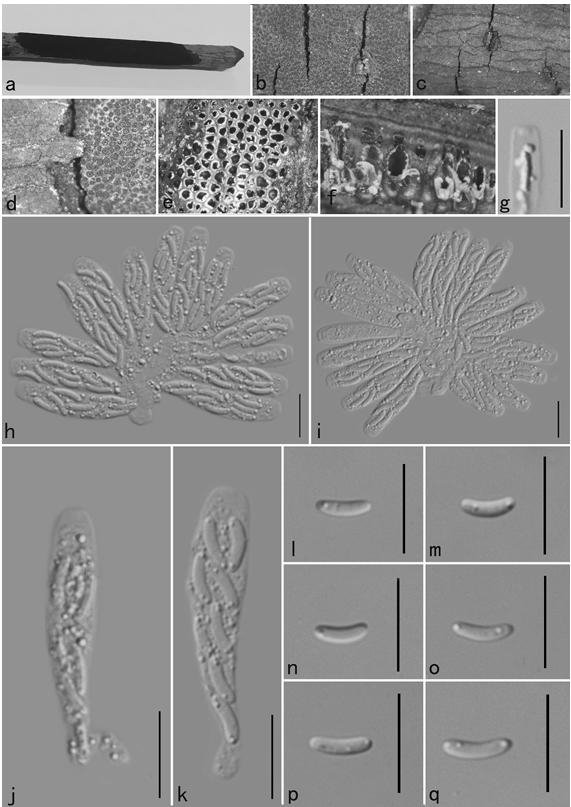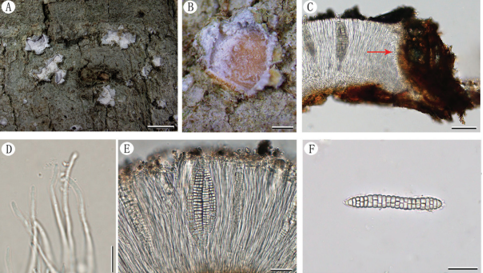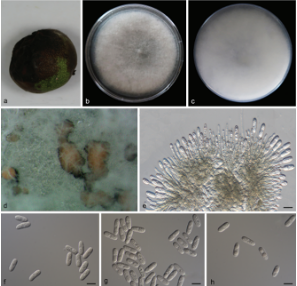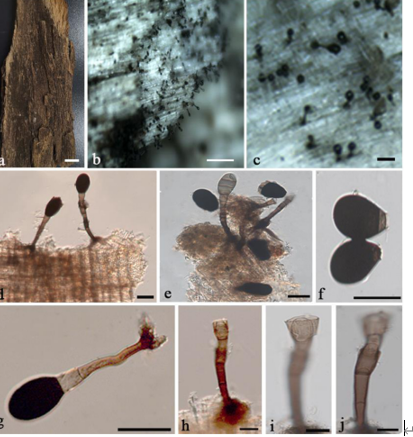Aurifilum terminali W. Wang & S.F. Chen 2020
MycoBank MB832458
Holotype:China, GuangDong Province, ZhanJiang Region, MaZhang District, HuGuang Town (N21°13'27.63" E110°17'19.32"), from twigs of one Terminalia neotaliala tree, 28 July 2016, S. Chen & W. Wang, CSFF2054 (holotype HMAS290466, ex-type culture CSF10757 = CGMCC3.19517).
Morphological description
No ascostromata were observed on the Eucalyptus bark collected from the plantations or on the inoculated Eucalyptus branch tissue. Conidiomata pycnidial, superficial to slightly immersed, yellow when young, bright orange when mature, solitary, constantly broadly convex, rostrate to conical, tissue around ostiolar openings darkened, necks appeared sporadically, constantly without necks. Conidiomatal base 213–924 µm (av. 524 µm) high above the level of bark and 100–665 µm (av. 263 µm) wide. Conidiomatal locules unilocular, locules 78–471 µm (av. 241 µm) diam. Stromatic tissue prosenchymatous. Conidiophores hyaline, branched irregularly at the base or above into cylindrical cells, with or without separating
septa, (8–)13.5(–21.5) µm (av. 13.5 µm) long. Conidiogenous cells phialidic, cylindrical with or without attenuated apices, (1.5–)2(–2.5) µm (av. 1.8 µm) wide. Paraphyses or cylindrical sterile cells occurring among conidiophores, up to 63 µm (av. 35µm). Conidia hyaline, aseptate, oblong to fusoid, occasionally allantoid, exuded through an opening at the stromatal surface as orange droplets, (3.5–)4(–4.5) × (1–)1.5(–2) µm (av. 3.9×1.6 µm).
Culture characteristics — Colonies on MEAfluffy with an uneven margin, white when young, turning orange after 10 d. Colony reverse orange. Optimal growth temperature (25–)30 °C, no growth at 5 °C.After 7 d, the colonies at 10 °C, 15 °C, 20 °C, 25 °C, 30 °C, and 35 °C had reached 13, 16, 36, 64, 68, and 29 mm, respectively.
Substrate — Bark of Terminalia neotaliala.
Habitat: From twigs of one Terminalia neotaliala tree.
Distribution: In China.
GenBank Accession: ITS: MN199837; tub2: MN258770; tub1: MN258775 ;tef1: MN258780 ; LSU: MN258785
Notes: Two species were described in the genus Aurifilum,
including Aur. marmelostoma and Aur. terminali. Aurifilum terminali morphologically differs from Aur. marmelostoma by the presence of conidiomatal necks (Begoude et al. 2010). Aurifilum terminali could also be distinguished from Aur. marmelostoma by growth characteristics in culture. At 10 °C and 35 °C, Aur. terminali grows relatively slowly, while no growth was observed for Aur. marmelostoma (Begoude et al. 2010).
Reference: W. Wang[1],2, G.Q. Li1, Q.L. Liu1 et al.

Asexual sporocarps of Aurifilum terminali. a. Orange conidiomata with orange necks; b– c. longitudinal section through the conidioma showing orange and unilocular stroma; d. prosenchymatous stromatic tissue of the conidioma; e–f. conidiophores and cylindrical conidiogenous cells; g. paraphyses; h. oblong to fusoid, aseptate conidia; i–j. living cultures after growing 7 d on MEA at 25 °C, (i) front, (j) reverse. — Scale bars: a = 100 µm; b– c = 50 µm; d = 10 µm;e–h = 5 µm; i–j = 10 mm.









